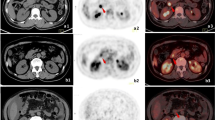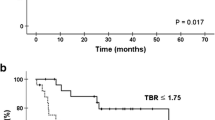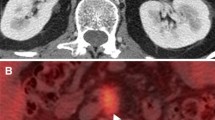Abstract
Purpose
To evaluate the additive value of whole-body F-18 fluoro-deoxyglucose positron emission tomography (FDG PET) as an adjunct to contrast-enhanced computed tomography (CECT) for detecting recurrence following Whipple’s resection for periampullary carcinoma and to analyze the prognostic significance of FDG PET-/CECT-based detection of recurrence.
Methods
Fifty patients (34 males, 16 females; mean age: 55 ± 11 years) who underwent PET/CECT following resection of periampullary carcinoma were included. The study was duly approved by the institutional ethical committee for retrospective analysis of the data. The sensitivity, specificity, positive predictive value (PPV), negative predictive value (NPV) and accuracy of FDG PET/CECT and CECT alone for detection of recurrence were calculated, and the accuracy was compared with ROC analysis. The prognostic factors for survival following recurrence were analyzed by univariate and multivariate methods.
Results
PET/CECT indicated recurrence of disease in 26 (52%) patients. The overall mean survival time was 46 months with an overall survival rate of 42%. The sensitivity, specificity, PPV, NPV and accuracy of PET/CECT and CECT for detection of recurrence were 96.1%, 91.6%, 92.6%, 95.6%, 94% and 76.9%, 75%, 76.9%, 75%, 76%, respectively (p = 0.037). Also change in management could have been achieved in 18% of patients based on the PET/CECT results. In univariate analyses, SUVmax >7.3 was the only predictor of poor survival (p < 0.05).
Conclusion
PET/CECT could be used as a one-stop imaging tool for staging and prognostication of recurrent periampullary carcinoma that could result in better patient management.




Similar content being viewed by others
References
Sarmiento JM, Nagomey DM, Sarr MG, Farnell MB (2001) Periampullary cancers: are there differences? Surg Clin North Am 81:543–555
Berberat PO, Kunzli BM, Gulbinas A, et al. (2009) An audit of outcomes of a series of periampullary carcinomas. Eur J Surg Oncol 35:187–191
Yeo CJ, Cameron JL, Sohn TA, et al. (1997) Six hundred fifty consecutive pancreaticoduodenectomies in the 1990s: pathology, complications, and outcomes. Ann Surg 226:248–257 (discussion 257–260)
Yeo CJ, Sohn TA, Cameron JL, et al. (1998) Periampullary adenocarcinoma: analysis of 5-year survivors. Ann Surg 227:821–831
Bouvet M, Gamagami RA, Gilpin EA, et al. (2000) Factors influencing survival after resection for periampullary neoplasms. Am J Surg 180:13–17
Schmidt CM, Powell ES, Yiannoutsos CT, et al. (2004) Pancreaticoduodenectomy: a 20-year experience in 516 patients. Arch Surg 139:718–725 (discussion 725–717)
Riall TS, Cameron JL, Lillemoe KD, et al. (2005) Pancreaticoduodenectomy with or without distal gastrectomy and extended retroperitoneal lymphadenectomy for periampullary adenocarcinoma–part 3: update on 5-year survival. J Gastrointest Surg 9:1191–1204 (discussion 1204-1196)
Kim JK, Ha HK, Han DJ, Auh YH (2003) CT analysis of postoperative tumor recurrence patterns in periampullary cancer. Abdom Imaging 28:384–391
Carter JT, Grenert JP, Rubenstein L, et al. (2008) Tumors of the ampulla of vater: histopathologic classification and predictors of survival. J Am Coll Surg 207:210–218
Kim WS, Choi DW, Choi SH, et al. (2012) Clinical significance of pathologic subtype in curatively resected ampulla of vater cancer. J Surg Oncol 105:266–272
Riall TS, Cameron JL, Lillemoe KD, et al. (2006) Resected periampullary adenocarcinoma: 5-year survivors and their 6- to 10-year follow-up. Surgery 140:764–772
Sperti C, Pasquali C, Fiore V, et al. (2006) Clinical usefulness of 18-fluorodeoxyglucose positron emission tomography in the management of patients with nonpancreatic periampullary neoplasms. Am J Surg 191:743–748
Ruf J, Lopez Hanninen E, Oettle H, et al. (2005) Detection of recurrent pancreatic cancer: comparison of FDG-PET with CT/MRI. Pancreatology 5:266–272
Sperti C, Pasquali C, Bissoli S, et al. (2010) Tumor relapse after pancreatic cancer resection is detected earlier by 18-FDG PET than by CT. J Gastrointest Surg 14:131–140
Mortele KJ, Lemmerling M, de Hemptinne B, et al. (2000) Postoperative findings following the Whipple procedure: determination of prevalence and morphologic abdominal CT features. Eur Radiol 10:123–128
Sperti C, Pasquali C, Catalini S, et al. (1993) CA 19-9 as a prognostic index after resection for pancreatic cancer. J Surg Oncol 52:137–141
Coombs RJ, Zeiss J, Howard JM, et al. (1990) CT of the abdomen after the Whipple procedure: value in depicting postoperative anatomy, surgical complications, and tumor recurrence. AJR Am J Roentgenol 154:1011–1014
Lepanto L, Gianfelice D, Dery R, et al. (1994) Postoperative changes, complications, and recurrent disease after Whipple’s operation: CT features. AJR Am J Roentgenol 163:841–846
Conflict of interest
None.
Author information
Authors and Affiliations
Corresponding author
Rights and permissions
About this article
Cite this article
Santhosh, S., Mittal, B.R., Kang, M. et al. Diagnostic accuracy of F-18 FDG PET/CECT vs. CECT for detecting recurrence of periampullary carcinoma and its prognostic significance. Abdom Imaging 40, 1131–1137 (2015). https://doi.org/10.1007/s00261-015-0371-6
Published:
Issue Date:
DOI: https://doi.org/10.1007/s00261-015-0371-6




